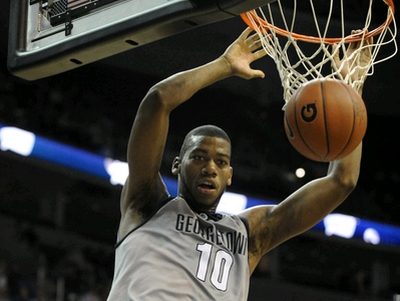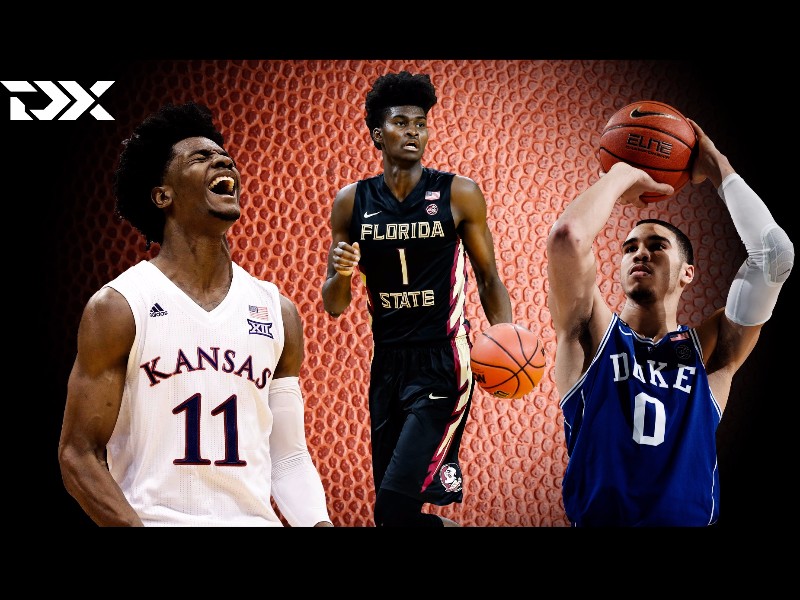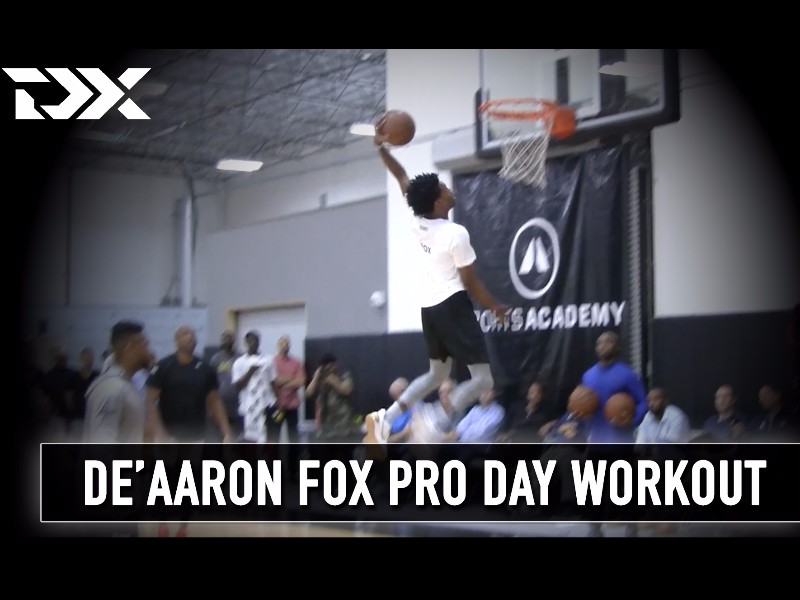As a reminder, incoming freshmen have been excluded from this series.
-Top NBA Draft Prospects in the Big Ten, Part One (#1-5), Part Two (#6-10), Part Three (#11-15)
-Top NBA Draft Prospects in the Big 12, Part One (#1-5), Part Two (#6-10), Part Three (#11-15)
-Top NBA Draft Prospects in the Pac-10 (Part One: #1-5), Part Two (#5-10)
-Top NBA Draft Prospects in the SEC Part One (#1-5), Part Two, Part Three,
Part Four
#1 Greg Monroe, 611, Sophomore, Power Forward / Center, Georgetown
Having profiled Monroe late last season, we will wait until the season kicks off to revisit his scouting report.
#2 Devin Ebanks, 68, Sophomore, Small Forward / Power Forward, West Virginia
Having profiled Ebanks late last season, we will wait until the season kicks off to revisit his scouting report.
#3 Stanley Robinson, 69, Sophomore, Small Forward / Power Forward, Connecticut
Having profiled Robinson during the tournament last season, we will wait until the season kicks off to revisit his scouting report.
#4 Kemba Walker, 60, Sophomore, Point Guard, Connecticut
Having profiled Walker late last season, we will wait until the season kicks off to revisit his scouting report.
#5 Terrence Jennings, 610, Sophomore, Power Forward / Center, Louisville
Matthew Williams
A former top-40 recruit, Terrence Jennings played sparingly for Rick Pitinos Cardinals during non-conference play early last season, but showed flashes of brilliance as Louisville ran through its conference schedule on their way to a 31-win season and a number 1 seed in the NCAA tournament. Playing only 11.9 minutes per-game, Jennings admittedly didnt make as big a splash as freshman teammate Samardo Samuels, but he cleared some significant hurdles that all young big men face and emerged as Samuelss backup by seasons end. Familiarizing himself with a new system, level of competition, and set of expectations in terms of preparation and practice, if nothing else, last season was an important learning experience for Jennings.
Despite the steps he took last season, he'll face a new set of challenges in 2010, likely playing more next to Samuels instead of behind him, having to help compensate for the departures of Earl Clark and Terrence Williams, and facing the added pressure of legitimizing his NBA stock.
It isnt hard to see what made Jennings such a highly regarded high school player coming out of Notre Dame Prep (MA) he definitely looks the part of an NBA big man. Standing near 6-10 with long-arms and a frame that could carry quite a bit of additional weight, Jennings has excellent physical potential. Couple his size with his excellent end-to-end speed, quick first step, and terrific leaping ability, and Jennings already sounds like an intriguing NBA prospect, even if he was only playing 11.9 minutes per-game last season. Though his physical profile is one of his biggest strengths as a prospect, it would be nice to see him continue adding strength to better fit the center position at the next level, as his skill level may not afford him the chance to play much power forward.
Though Jennings's size, speed, and athleticism gave him the ability to score around the rim in face-up situations on the high school level, his lack of polish was apparent on the block in his first season at Louisville. Displaying a knack for beating his man up the floor, a willingness to get low and establish position, and earning quite a few dunks at the rim by pinning his defender near the mid-post, Jennings flashes a quick spin move that lets him use his excellent leaping ability at the rim when finishing, but that is about the extent of his polish in the post at this point.
When he cant simply catch and turn over his left shoulder for a hook shot or lay in, Jennings struggles with counter-moves, appears uncomfortable or tentative at times, and gets his shot blocked rather frequently for an athlete of his caliber. As of last season, Jennings scored almost exclusively as a finisher at the rim, as jumpers accounted for only 3% of his total shots according to Synergy Sports Technology, and his 51.0% foul shooting indicates that hell need to improve the follow through and rhythm he displays in his mechanics if he wants to add some range to his game.
Despite how raw he appears in any situation where he has to create anything for himself, Jennings does excel when his teammates can create open looks for him. Offering a big target, moving well on the interior, and aggressively looking to gain position, Jennings converted nearly 66.7% of his finishing opportunities inside, many of which he earned himself on the offensive glass, where he would rank amongst the more prolific per-40 producers if he were statistically qualified.
Playing next to Samardo Samuels for the foreseeable future, it will be important for Jennings to continue working hard on the glass and improve his comfort level operating in the midrange to better produce in a complementary role. Clearly, Jennings has some promising offensive tools that will need time to develop, not too unlike what he brings to the table defensive.
Not terribly foul prone for a young, raw post, Jennings utilizes his length well to contest shots around the basket and shows good instincts and quick hands as shot blocker. With the lateral quickness to compensate for some lapses in positioning on the interior, Jennings has the potential to be a very high level defensive player. Already posting impressive per-40 block numbers, albeit in a small sample of minutes, Jennings will have the opportunity to solidify his reputation as an intimidating shot blocker next season. With Samardo Samuels defending stronger interior players, Jennings will likely spend more time defending the perimeter rather than sitting under the rim in Louisvilles zone like he did this year. That will factor into his productivity, but it will also require him to improve his discipline when closing out shooters, one area where Jennings displays consistently poor fundamentals defensively.
Already possessing the athleticism and body of an NBA player and some intriguing tools, it will be interesting to see if Jennings can extrapolate his productivity as he moves into a starting role. Essentially a clean slate as a player, Jennings doesnt have great instincts offensively, nor does he have too many bad habits. His development as a scoring threat and defensive presence will dictate how NBA decision-makers view him next summer, as will his ability to shed the poor reputation hes garnered off the court through his prep days. This could very well be the key to his draft stock actually, as any red flags that come up in the pre-draft process about his character could significantly hurt him.
A former top-40 recruit, Terrence Jennings played sparingly for Rick Pitinos Cardinals during non-conference play early last season, but showed flashes of brilliance as Louisville ran through its conference schedule on their way to a 31-win season and a number 1 seed in the NCAA tournament. Playing only 11.9 minutes per-game, Jennings admittedly didnt make as big a splash as freshman teammate Samardo Samuels, but he cleared some significant hurdles that all young big men face and emerged as Samuelss backup by seasons end. Familiarizing himself with a new system, level of competition, and set of expectations in terms of preparation and practice, if nothing else, last season was an important learning experience for Jennings.
Despite the steps he took last season, he'll face a new set of challenges in 2010, likely playing more next to Samuels instead of behind him, having to help compensate for the departures of Earl Clark and Terrence Williams, and facing the added pressure of legitimizing his NBA stock.
It isnt hard to see what made Jennings such a highly regarded high school player coming out of Notre Dame Prep (MA) he definitely looks the part of an NBA big man. Standing near 6-10 with long-arms and a frame that could carry quite a bit of additional weight, Jennings has excellent physical potential. Couple his size with his excellent end-to-end speed, quick first step, and terrific leaping ability, and Jennings already sounds like an intriguing NBA prospect, even if he was only playing 11.9 minutes per-game last season. Though his physical profile is one of his biggest strengths as a prospect, it would be nice to see him continue adding strength to better fit the center position at the next level, as his skill level may not afford him the chance to play much power forward.
Though Jennings's size, speed, and athleticism gave him the ability to score around the rim in face-up situations on the high school level, his lack of polish was apparent on the block in his first season at Louisville. Displaying a knack for beating his man up the floor, a willingness to get low and establish position, and earning quite a few dunks at the rim by pinning his defender near the mid-post, Jennings flashes a quick spin move that lets him use his excellent leaping ability at the rim when finishing, but that is about the extent of his polish in the post at this point.
When he cant simply catch and turn over his left shoulder for a hook shot or lay in, Jennings struggles with counter-moves, appears uncomfortable or tentative at times, and gets his shot blocked rather frequently for an athlete of his caliber. As of last season, Jennings scored almost exclusively as a finisher at the rim, as jumpers accounted for only 3% of his total shots according to Synergy Sports Technology, and his 51.0% foul shooting indicates that hell need to improve the follow through and rhythm he displays in his mechanics if he wants to add some range to his game.
Despite how raw he appears in any situation where he has to create anything for himself, Jennings does excel when his teammates can create open looks for him. Offering a big target, moving well on the interior, and aggressively looking to gain position, Jennings converted nearly 66.7% of his finishing opportunities inside, many of which he earned himself on the offensive glass, where he would rank amongst the more prolific per-40 producers if he were statistically qualified.
Playing next to Samardo Samuels for the foreseeable future, it will be important for Jennings to continue working hard on the glass and improve his comfort level operating in the midrange to better produce in a complementary role. Clearly, Jennings has some promising offensive tools that will need time to develop, not too unlike what he brings to the table defensive.
Not terribly foul prone for a young, raw post, Jennings utilizes his length well to contest shots around the basket and shows good instincts and quick hands as shot blocker. With the lateral quickness to compensate for some lapses in positioning on the interior, Jennings has the potential to be a very high level defensive player. Already posting impressive per-40 block numbers, albeit in a small sample of minutes, Jennings will have the opportunity to solidify his reputation as an intimidating shot blocker next season. With Samardo Samuels defending stronger interior players, Jennings will likely spend more time defending the perimeter rather than sitting under the rim in Louisvilles zone like he did this year. That will factor into his productivity, but it will also require him to improve his discipline when closing out shooters, one area where Jennings displays consistently poor fundamentals defensively.
Already possessing the athleticism and body of an NBA player and some intriguing tools, it will be interesting to see if Jennings can extrapolate his productivity as he moves into a starting role. Essentially a clean slate as a player, Jennings doesnt have great instincts offensively, nor does he have too many bad habits. His development as a scoring threat and defensive presence will dictate how NBA decision-makers view him next summer, as will his ability to shed the poor reputation hes garnered off the court through his prep days. This could very well be the key to his draft stock actually, as any red flags that come up in the pre-draft process about his character could significantly hurt him.


































Comments